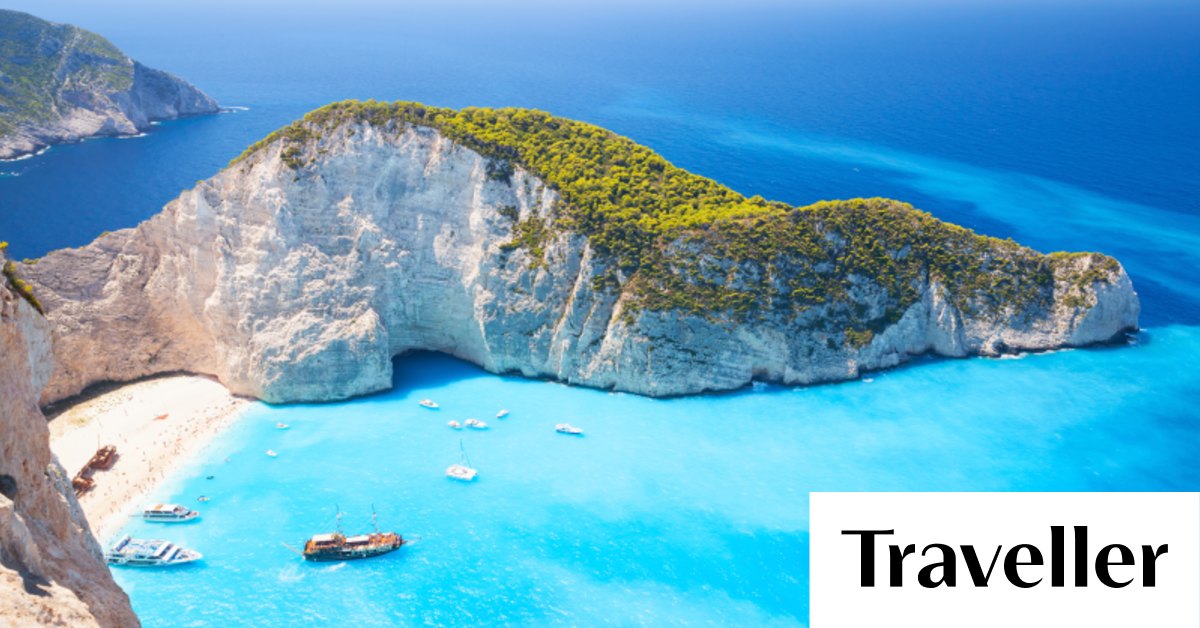Climbing aboard the Sol Ana, skippered by amiable Gianis Papadogeorgos, I am shown to my room. The 15-metre yacht, named after the skipper’s two daughters, has eight cabins, four double berths and two windowless singles (ideal for teenagers). A huge soft bed fills my room, which is lined with shelves, built-in USB sockets and (European) power points on both sides.
Storage consists of a cupboard with a hanging rail and two shelves, plus another open set of three shelves and a huge drawer under the bed if you need it (I didn’t).
Small boats can reach parts of Zakynthos others can’t.
I’ve packed a roll-on’s worth of clothes and it all fits beautifully. I could have fit twice the amount of toiletries I’d brought on the bathroom’s five shelves. The shower pressure is firm, the water blissfully hot, and the ensuite is larger than some bathrooms in Airbnbs I’ve stayed in.
Two waterproof jackets with hoods for the cooler nights and faster pace at sea hang in the cupboard. I’m delighted and grateful to discover them as it was the only item of clothing I’d been advised to bring that I didn’t have.
Bright light pours through the hatch above the pillows and to the side is a long horizontal window, from which I watch the sky turn various shades of pink one morning when I wake early and the rest of the boat sleeps.
With its neutral colour scheme, there’s a laid-back luxury feel to the entire boat. But it also feels lived-in, thanks to a kitchen equipped with proper cooking gear including smoothie-makers and two types of coffee machines (along with the traditional pot required to concoct Greek coffee).
Australian-Greek chef Noah interrupted his year-long backpacking tour around Greece with his girlfriend Eve and their friend Tyanna (both also Australian Greeks) to crew our voyage. He loves the set-up, which shows in the delectable but simple food he whips up.
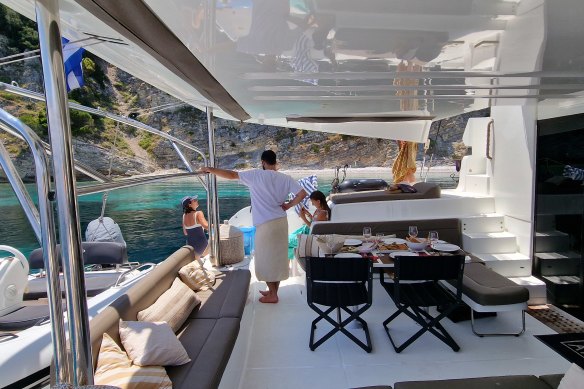
Relaxing on deck on Luxe Sailing’s luxury yacht.
Sol Ana’s top and front decks provide plenty of lounging options and even space for some modified yoga and pilates.
Setting sail is a journey into simplicity and a reminder that the best things in life are nature, food and rest and perhaps we should add, being afloat.
The Ionian Sea, a gentle body of water, hosts many remote and uninhabited islands. This not only makes it ideal for novice sailors wanting to try their hand (something guests are encouraged to try if they feel like it – I most certainly do not) but also for close encounters with nature.
This happens one day as we sail towards our next island for lunch when the cry of “dolphins” rings out. We scramble to the front deck, part of which is covered in netting only, making for an over-water hammock.
A pod of dolphins joyfully curves in and out of the water, by the side and underneath the boat.
The cetaceans play for a good 30 minutes and come right below the netted deck, seemingly within touching distance.
It’s a magical experience and, I remind myself, the kind that only comes with travelling this way.
The close encounter with the silver mammals is just one, albeit a blockbuster, of the many joys travelling on water brings.
Sol Ana comes equipped with a runabout, paddleboards, snorkels and an underwater scooter. The toys make for much fun when we anchor off the remote coastlines of the islands that can be reached only by water.
The beaches, set against stunning backdrops of sheer rock cliffs, might be pebbles, not sand, but they are pristine and wonderfully desolate. Some don’t even have names; Papadogeorgos just knows them in his mental map. Their isolation can only be broken by those able to swim onshore.
It’s not much of a surprise, at one beach, to come across nudists who exploit the open-air privacy.
This is a trip to practise your technique before you set sail. No sooner am I standing on a paddleboard than skipper Gianis lets loose his latest acquisition – a 4K drone that busily buzzes overhead while we swim and land on deserted beaches.
Loading
Many of the Ionian islands began forming during the Triassic-Jurassic age and the limestone cliffs that rise from the sparkling aquamarine waters were, millions of years ago, underwater.
Many of the beaches that embellish the coastline are inaccessible, or damned hard to reach. This also applies for the natural and breathtaking formations that form where land meets sea.
Then there are the caves – nature’s cathedrals. To swim out to them is a spiritual experience in itself. Floating, I’m joined only by a seagull whose belly is lit up a brilliant blue, reflecting the turquoise water below.
Papadogeorgos ferries us to and from the famous blue caves, reflecting the colour of the water below. Mesmerising, spectacular and unforgettable. These are very much the images that return when I close my eyes and recall the trip.
No day is spent entirely on the water. This is, after all, a journey to the Ionian islands. From Paleros, we headed to Vathy on the largest of the Ionian islands, Ithaca.
The bulk of our sailing was to Ithaca, Lefkada and Kefalonia and Zakynthos. The smaller and more humble the island, the cheaper and usually better the food, the views and the greater the peacefulness.
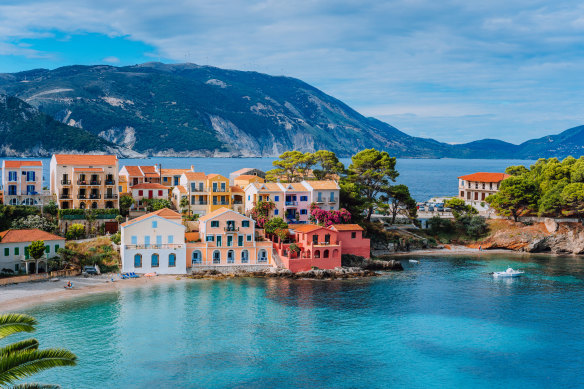
Picture perfect … Assos village in Kefalonia.Credit: iStock
There’s nothing quite like the narrow gangway being lowered onto a promenade between tables of diners to make you feel instantly connected to a new island.
Each island has its own distinctive charms. Fuchsia-coloured bougainvillea spills from balconies and rooftops, cats roam streets and seem to pose in front of buildings painted in glowing, warm colours.
It’s an Instagrammer’s delight. But happily, there is nothing pretentious. Just like the food, it’s local, bursting with local personality and at many points, the rustic merges into downright dilapidated.
I sip an espresso sitting on the edge of a dock, feet in glistening water, viewing an old stone lighthouse atop the cliff. It feels as if these places have another decade left before they are full-blown tourist hot-spots or the next party destination.
It’s well worth stopping in at the tiny boutiques filled with local fashions, jewellery, art, homewares, natural cosmetics and speciality foods (think oils, spices, salts and olives).
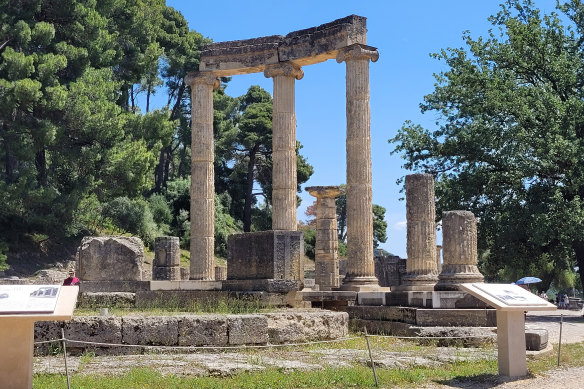
Detour to the mainland for a day trip to Ancient Olympia.
It was a joy to see the tags of beautifully knitted dresses and clothes proudly claiming “Made in Greece” (although there’s plenty of cheap polyester “Made in China” garb available as well).
There is no chance I’ll go stir-crazy. We abandon Sol Ana for a day and head to the mainland to tour Ancient Olympia. (Did you know the ancient Greek Olympians mixed dust with olive oil for sunscreen?)
As I discover over the course of the week, all the islands have beautiful hiking trails that twist between ports – several times, we drop off at one port and arrange to be picked up at another. This is not just a trip to bring your swimsuits and sunscreen but also your activewear.
One morning, after traversing Ithaca, I’m delighted to find Filiatro Beach completely empty and the shaded yoga deck unoccupied. I can safely say I’ve never planked in a more beautiful spot.
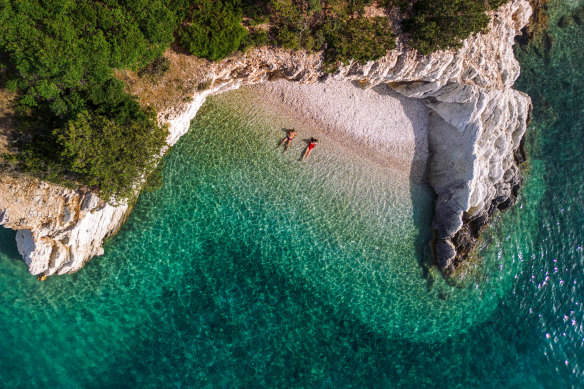
Filiatro Beach on Ithaca Island is a beautiful spot.Credit: iStock
This is when Kokkinos arrives in the runabout to pick me up.
“If I die having only ever come back to Greece, that’s fine with me,” he tells me. As I grudgingly extract my feet from water so clear that “glass” is an inadequate comparison, it is hard to disagree.
Gaia, spirit of the Earth, must surely have been Ionian.
THE DETAILS
Visa
Australians can travel to Greece visa-free for 90 days but your passport must have six months validity and one blank page.
Fly
There are no direct flights between Australia and Greece. Singapore Airlines flies Australia to Europe via Changi, Istanbul and Rome. Scoot flies Sydney to Athens via Changi. Emirates and Qatar fly to Greece via their Dubai and Doha hubs respectively.
Loading
Sail
An all-inclusive skippered seven-day sailing for eight people around the Ionian Islands costs from $3250 a person. Transfers can be arranged from hotels and airports. See luxesailing.com.au
The writer travelled as a guest of Luxe Sailing.
Find great deals on cruises at mycruises.com.au

